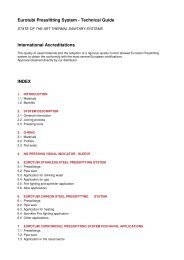corrosion of stainless steel - Damstahl
corrosion of stainless steel - Damstahl
corrosion of stainless steel - Damstahl
You also want an ePaper? Increase the reach of your titles
YUMPU automatically turns print PDFs into web optimized ePapers that Google loves.
Chapter 6 - Corrosion <strong>of</strong> Stainless Steel<br />
Figure 6.7:<br />
Severe penetration in a buried <strong>stainless</strong> <strong>steel</strong> pipe (4404) as a result <strong>of</strong><br />
short distance to a buried, live cable. This has pushed the <strong>steel</strong> from its<br />
ideal passive condition to 'transpassive', and <strong>corrosion</strong> commences. Note<br />
the lack <strong>of</strong> small <strong>corrosion</strong> pits.<br />
This effect is sometimes called 'stray currents', and the way to prevent these<br />
is to ensure sufficient electrical resistance between cables and <strong>steel</strong> pipes<br />
either by avoiding the pipes and cables being too close or by ensuring that<br />
the water content in the ground is kept sufficiently low - and that addition<br />
<strong>of</strong> electrically conductive salts is avoided. Alternatively, an 'insert' can be<br />
introduced, e.g. carbon <strong>steel</strong>, which can function as an 'electric screen'<br />
between the cable and the <strong>stainless</strong> <strong>steel</strong> pipe.<br />
'Fishing line<br />
<strong>corrosion</strong>'<br />
6.2 Pitting <strong>corrosion</strong><br />
The mechanism <strong>of</strong> pitting <strong>corrosion</strong> is the complete opposite <strong>of</strong> general<br />
<strong>corrosion</strong>. While general <strong>corrosion</strong> causes an even and homogenous<br />
breakdown <strong>of</strong> the protective oxide layer and subsequent homogenous<br />
<strong>corrosion</strong>, pitting causes local breakdown <strong>of</strong> the oxide layer. This local<br />
breakdown makes the <strong>steel</strong> produce an 'internal galvanic coupling' (see<br />
Chapter 5) where the small, corroding stain functions as an anode while<br />
the rest remains an inert cathode.<br />
Pitting <strong>corrosion</strong> is the perfect example <strong>of</strong> an either/or type <strong>of</strong> <strong>corrosion</strong>.<br />
Where general <strong>corrosion</strong> produces large material loss expressed in g/m 2 ,<br />
pitting <strong>corrosion</strong>, on the other hand, results in a very small loss <strong>of</strong> material.<br />
However, as the attack is local rather than general, penetration may occur<br />
very quickly. Pitting <strong>corrosion</strong> is the ultimative 'fishing line <strong>corrosion</strong>' (see<br />
Figure 5.12 on page 71), where either things go perfectly well forever or where<br />
penetration takes place in a very short period <strong>of</strong> time.<br />
Whether general <strong>corrosion</strong> or pitting <strong>corrosion</strong> takes place is usually a<br />
question <strong>of</strong> the acidity <strong>of</strong> the solution. At very low or very high pH a general<br />
83<br />
RS for alle.indb 83<br />
9/29/2011 12:44:34 PM

















